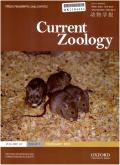Sexual differences in bite force are not related to testosterone level in the wild-derived red junglefowl
IF 2
2区 生物学
Q2 ZOOLOGY
引用次数: 0
Abstract
Bite force is an important performance indicator of individual fitness that is closely related to food acquisition, male competition, and mating selection. It is also affected by a variety of factors and different mechanisms. Therefore, it is relatively difficult to understand the evolutionary driving forces of changes in bite force. In this study, the driving factors affecting the bite force of wild-derived red junglefowl (Gallus gallus jabouillei) were investigated from the aspects of morphological indicators and physiological characteristics. Results showed that the bite force of wild-derived red junglefowl was directly related to sex, showing obvious sexual differences. However, there was no correlation between the plasma testosterone level and bite force. The bite force of males was significantly greater than that of females, and the body index (i.e., PC1 of five body measures, namely body mass, body length, wing length, tail length and tarsus length), the grasp index (i.e., tomial length × bill width) of males were significantly greater than those of females. Sexual selection may have played a key role in the evolution of bite force in the red junglefowl. Future studies should examine other key factors affecting changes in bite force, to verify the correlation between secondary sexual characteristics and bite force in red junglefowls.野生红丛林鸟咬合力的性别差异与睾酮水平无关
咬合力是个体适应性的一个重要性能指标,与食物获取、雄性竞争和交配选择密切相关。它还受到多种因素和不同机制的影响。因此,了解咬合力变化的进化驱动力相对困难。本研究从形态指标和生理特点两方面研究了影响野生赤麻鸡(Gallus gallus jabouillei)咬合力的驱动因素。结果表明,野生赤麻鸡的咬合力与性别直接相关,表现出明显的性别差异。但血浆睾酮水平与咬合力之间没有相关性。雄鸟的咬合力显著大于雌鸟,雄鸟的身体指数(即体质量、体长、翅长、尾长和跗长五项身体指标的PC1)、抓握指数(即喙长×喙宽)显著大于雌鸟。性选择可能在红色丛林鸟咬合力的进化过程中起到了关键作用。未来的研究应考察影响咬合力变化的其他关键因素,以验证红丛林鸟第二性征与咬合力之间的相关性。
本文章由计算机程序翻译,如有差异,请以英文原文为准。
求助全文
约1分钟内获得全文
求助全文
来源期刊

Current Zoology
Agricultural and Biological Sciences-Animal Science and Zoology
CiteScore
3.20
自引率
9.10%
发文量
111
审稿时长
6 weeks
期刊介绍:
About the Journal
Current Zoology (formerly Acta Zoologica Sinica, founded in 1935) is an open access, bimonthly, peer-reviewed international journal of zoology. It publishes review articles and research papers in the fields of ecology, evolution and behaviour.
Current Zoology is sponsored by Institute of Zoology, Chinese Academy of Sciences, along with the China Zoological Society.
 求助内容:
求助内容: 应助结果提醒方式:
应助结果提醒方式:


